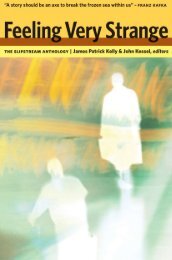The Curse of the Wer.. - Site de Thomas - Free
The Curse of the Wer.. - Site de Thomas - Free
The Curse of the Wer.. - Site de Thomas - Free
Create successful ePaper yourself
Turn your PDF publications into a flip-book with our unique Google optimized e-Paper software.
122 THE CURSE OF THE WEREWOLF<br />
stripped cyclic imagery <strong>of</strong> its association with renewal and fertility,<br />
representing it instead as a source <strong>of</strong> futile sterility.<br />
<strong>The</strong> parallel between lycanthropy and menstruation has been an<br />
obvious <strong>the</strong>me for stories about female lycanthropy, especially in <strong>the</strong><br />
wake <strong>of</strong> <strong>the</strong> feminist movement, which challenged <strong>the</strong> taboos on talking<br />
and writing about such subjects. In ‘Lila <strong>the</strong> <strong>Wer</strong>ewolf’ (1978), Peter S.<br />
Beagle’s story about a man who discovers his girlfriend is a werewolf,<br />
lycanthropy is overtly compared to menstruation, as a condition which<br />
requires un<strong>de</strong>rstanding. As Lila explains, she has lived with <strong>the</strong> problem<br />
for nine years, ‘Since I hit puberty. First day, cramps; <strong>the</strong> second<br />
day, this. My introduction to womanhood.’ 25 Lila is not characterized<br />
as dangerous or malicious; instead, Beagle presents her condition as a<br />
slightly more extreme manifestation <strong>of</strong> every woman’s ‘condition’.<br />
A week or so before <strong>the</strong> full moon, she would start to become nervous and<br />
stri<strong>de</strong>nt, and this would continue until <strong>the</strong> day preceding her transformation.<br />
On that day, she was invariably loving, in <strong>the</strong> ten<strong>de</strong>r, <strong>de</strong>sperate<br />
manner <strong>of</strong> someone who is going away; but <strong>the</strong> next day would see her<br />
silent, speaking only when she had to. 26<br />
Thus, <strong>the</strong> bodily cycles <strong>of</strong> werewolves and women are not <strong>de</strong>monized<br />
as a source <strong>of</strong> abject horror in Beagle’s story; ra<strong>the</strong>r, lycanthropy<br />
is presented as a vaguely amusing domestic inconvenience. Beagle’s<br />
casting <strong>of</strong> Lila’s lycanthropy as a comic and suburban matter contrasts<br />
markedly with <strong>the</strong> wi<strong>de</strong>spread construction <strong>of</strong> male lycanthropy as a<br />
‘serious’ and ‘tragic’ concern (an attitu<strong>de</strong> that is un<strong>de</strong>rlined fur<strong>the</strong>r<br />
by My Mom’s a <strong>Wer</strong>ewolf (1988, USA), a comedy in which a neglected<br />
housewife is featured trying to file her teeth, wax her facial hair and<br />
shave <strong>the</strong> pelt from her legs). Never<strong>the</strong>less, Beagle’s story also set <strong>the</strong><br />
tone for a number <strong>of</strong> explorations <strong>of</strong> female lycanthropy by female writers,<br />
who have <strong>de</strong>liberately adopted a lighter approach to <strong>the</strong> material.<br />
Suzy McKee Charnas’s ‘Boobs’ (1989), for example, narrates <strong>the</strong> story<br />
<strong>of</strong> Kelsey, who begins changing into a wolf when she has her first<br />
period. She takes time to adjust to her new gift for transformation,<br />
but by <strong>the</strong> end <strong>of</strong> <strong>the</strong> story she has metamorphosed from an awkward<br />
adolescent into a confi<strong>de</strong>nt young woman who no longer has to put





